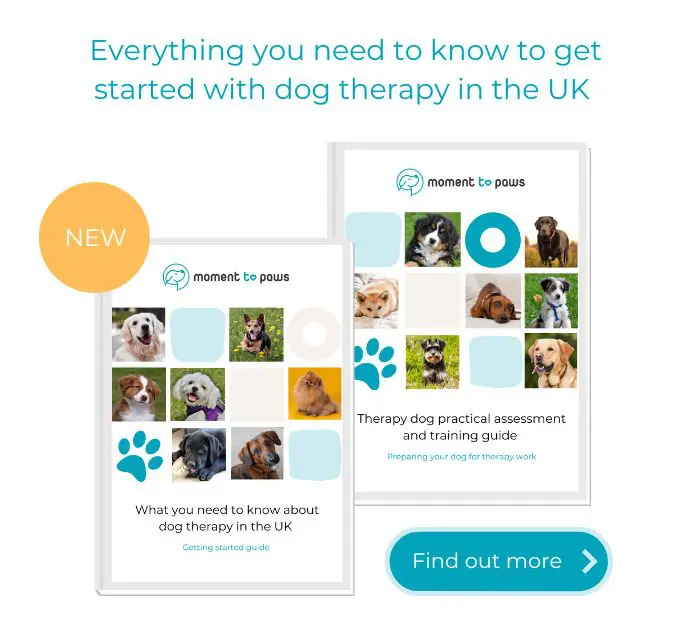
Alternative and unique ideas to boost employee wellbeing in the workplace
1 April 2022
Top Tips For Bring Your Dog To Work Day 2022 | June 24th 2022
30 May 2022When an industry is unregulated, it can be hard to sift through the information that’s out there in order to know what the ‘right’ thing to do is. And unfortunately, shocking as it is in 2022, there is currently no regulation for the use of therapy dogs in the UK.
Generally speaking there are four routes you can choose to go down in order to undertake canine assisted therapy:
- Join a pet therapy charity as a volunteer
- Be an independent volunteer
- Be an independent specialist offering a paid for service
- Become a dual role practitioner team such as a teaching assistant, SEN teacher, counsellor, coach or health professional.
1. Join a pet therapy charity as a volunteer
Another UK based pet therapy organisation is Therapy Dogs Nationwide which was established in 2016 and is managed entirely by volunteers. In Scotland, Therapet (managed by Canine Concern Scotland Trust) is the leading pet therapy organisation. Volunteer owners must become members of Canine Concern Scotland Trust and be willing to commit to regular visits.
Working with a charitable organisation such as Pets As Therapy or Therapy Dogs Nationwide brings with it a number of benefits. Arguably the main benefit is that they take a degree of administration and risk off your shoulders, also covering you from an insurance perspective. This gives you the freedom to concentrate on your dog and building a great relationship with those you are visiting.
A lot of people who decide to go down the route of dog therapy already have an organisation in mind; whether it’s your local hospital, the school your children attend or a care home where a loved one lives. However if you don’t have an establishment in mind and simply want to be able to offer your service to those in need, joining a charity as a volunteer may also help you to source places to visit.
Another reason that people choose to go down the volunteer route with a charity is that you have the backing of a recognised brand and will be able to get branded clothing which can give you a sense of professionalism. What’s more, you will be a part of a growing network of volunteers, providing you with support and connecting you with like minded people.
Though the process may differ slightly between organisations, you and your dog will need to undertake an assessment prior to joining as a volunteer. Though many people may worry about this, it is generally nothing to worry about. Remember, a great therapy dog is one who has strong basic obedience skills, a calm and friendly temperament and who isn’t worried by unexpected noises, movement or items.
2. Volunteer independently
Some people prefer the freedom of being an independent volunteer which is another valid route into pet therapy.
Naturally, if you don’t have the backing of an umbrella organisation, you will need to be more diligent when it comes to agreements, insurance and health and safety. Even though you are volunteering your services, it’s important that you have an agreement in place between you and the establishment where you are looking to take your therapy dog, so that everyone’s expectations are clearly managed.
You will also need to be covered by public liability insurance for pet therapy work. Many insurance companies now offer this and you can expect to pay around £100 – £180 depending on the scope of your work and the area in which you operate.
Please remember to check your pet insurance policy. Many policies contain clauses which means your dog won’t be insured if they come to harm while engaging in therapy work so it’s essential that your insurance policy covers this.
If you do decide to go down this route, we highly recommend speaking with a qualified dog trainer or behaviourist who can assess your dog prior to engaging in therapy work. Canine body language can be incredibly subtle and without a trained eye, it’s possible to miss signs of stress and anxiety. As a minimum, you should get your dog assessed every year, however if you’re engaging in therapy work as often as every week, think about speaking with a specialist every six months. It would also be very beneficial to learn more about canine body language and / or take a course so that you can learn to spot if your dog isn’t happy and / or needs a break.
3. Independent paid for service
As the value of pet therapy is becoming more widely recognised, there is a growing willingness to pay for dog therapy support. Everything noted under the independent volunteer route remains the same; you will need to ensure you have a clear agreement in place, insurance, take into account health and safety considerations and ensure your dog’s welfare is looked after.
In addition, you will need to set out the price that you charge for your service and agree this with the establishment. You’re offering a very valuable service which will bring an awful lot of benefits to those involved so there’s no need to be embarrassed about this. However, as with everything, if you’re charging for a service, it brings with it certain expectations. This is why it’s so important to get an agreement in place so that expectations can be managed from the beginning.
Don’t forget, if you are offering a paid for service, you will need to declare it to the various authorities.
4. Dual role practitioner team
A lot of teachers come to us who recognise how much benefit their own dog could bring to the children. Similarly, those working in health care, as counsellors or as coaches recognise that their dog would bring benefits to their patients and clients.
When carefully managed and implemented, a dual role partnership can be hugely successful and beneficial to all parties. Naturally, you already know the beneficiaries well, and you get to take your dog to work with you (what’s not to love?!).
One of the main things to consider when taking your dog into your place of work to benefit your pupils, patients or clients is the welfare of your dog. If you are working for seven hours, remember that your dog is too. It is very easy for them to become stressed in a busy environment, regardless of how much they love people. Therefore it’s important that your dog has space away from therapy work where they can rest undisturbed. Generally speaking, a dog can engage in therapy work for around 45 minutes before needing a break so ensure this is planned into your day.
Taking your dog to work with you can also be tough on you personally. When you have to deal with the demands of other around you, while also balancing the welfare of your dog, it can be tricky. However if you can make it work for you and others, the reward will be significant.
Often the most successful partnerships are when an individual works part time with their dog, as an additional activity to their paid employment. As the benefits of dog therapy become more widely recognised in the UK, it is our hope that regulation will be established, both for the safety of individuals and the welfare of all the amazing dogs out there.








